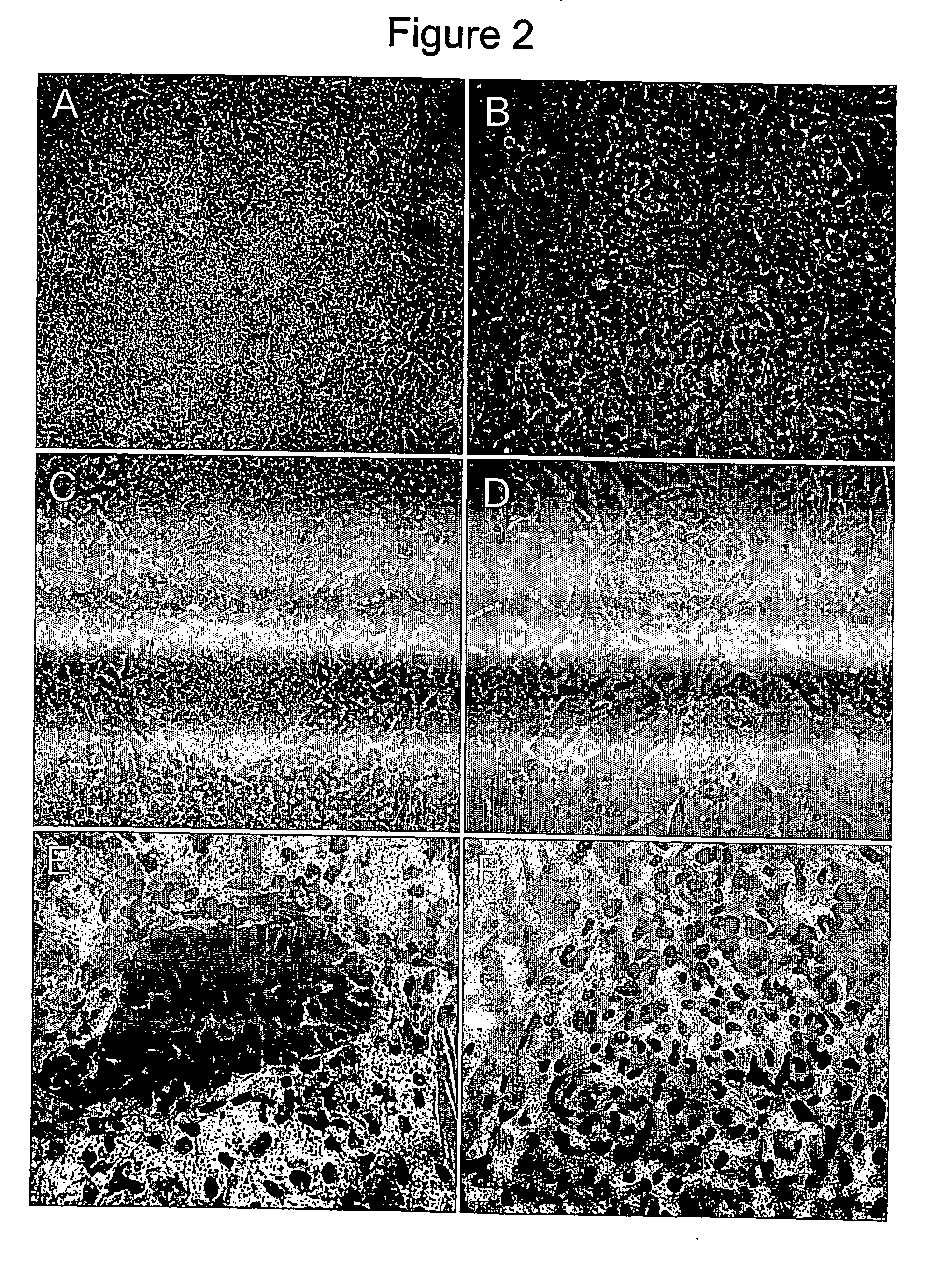Compositions and methods for the control, differentiaton and/or manipulation of pluripotent cells through a gamma-secretase signaling pathway
a technology of gamma secretase and signaling pathway, which is applied in the field of control, differentiation and/or manipulation of pluripotent cells via modulation of gamma secretase or notch signaling pathway, can solve the problem of reducing the percentage of spontaneously differentiated cells in pluripotent cell culture, and achieve the effect of reducing the percentage of spontaneously differentiated cells
- Summary
- Abstract
- Description
- Claims
- Application Information
AI Technical Summary
Benefits of technology
Problems solved by technology
Method used
Image
Examples
example 1
Notch1 is a Marker for Undifferentiated Human ES Cells and is Down-Regulated upon Differentiation
Materials and Methods
Antibodies
[0135] Antibodies to SSEA1, SSEA3, SSEA4, and bTAN20 (Notch1) were all from Developmental Studies Hybridoma Bank. Notch-1(H-131) is a rabbit polyclonal antibody from Santa Cruz Technologies. Antibodies to TRA-1-60 and TRA-1-81 were a gift from Peter Andrews.
[0136] Cells on chamber slides were rinsed once with 1× PBS and fixed for 30 minutes in 4% PFA / 4% sucrose in PBS pH7.4 at room temperature for surface staining, or in ice cold 100% methanol for 5 minutes at −20° C. followed by 4% PFA / 4% sucrose in PBS for 10 minutes at room temperature for intracellular staining using the bTAN20 antibody. They were rinsed 3× in 1×PBS and blocked in 3% goat serum / 1% PVP with or without 0.3% Triton-X100 in PBS for 30 minutes at 4° C. Primary antibodies were diluted in blocking solution and this solution was applied overnight at 4° C. to the cel...
example 2
Heterogeneity of Manual and Trypsin Passaged HESCs
Materials and Methods
Antibodies
[0149] Antibodies to SSEA1, SSEA3, SSEA4, Notch1 (H-131), bTAN20 (Notch 1), TRA-1-60, and TRA-1-81 were obtained as described in Example 1. Antibodies to C651.6DbHN (Notch-2) were from Developmental Studies Hybridoma Bank. Antibodies to Oct-4 (catalog No. sc-5279) were from Santa Cruz Technologies. Presenilin-1 (catalog No. MAB5232) and Nicastrin (catalog No. AB5890) antibodies were from Chemicon International, Inc. The antibody to HDAC2 was from Zymed Laboratories, Inc. The Cleaved Notch1 antibody (NICD; catalog No. 2421) was from Cell Signaling Technology, Inc. Secondary Alex Fluor conjugated antibodies were from Molecular Probes, Inc.
[0150] Immunohistochemistry was performed as described in Example 1.
Western Blots
[0151] Western blots were done using standard procedures. In brief, protein content of samples was determined with a BCA micro protein assay (Pierce, Rockford,...
example 3
Expression of Notch Family Members and the Gamma-Secretase Complex in HESCs
[0161] Notch signaling that is mediated by a gamma-secretase mediated cleavage has previously been shown to control differentiation and proliferation in many developmental contexts. Here it is shown that hES cells express Notch-1, -2, and -3, and active forms of components of the gamma-secretase complex.
[0162]FIG. 7A shows RT-PCR analysis indicating strong expression of Notch-1, -2, and -3 in HESCs. Notch-4 was only weakly detected. In a separate set of experiments, Notch-4 was not detected. Lack of expression of Notch-4 was verified using an independent set of PCR primers. Protein for Notch-1, and -2 was detected by Western blotting using three different antibodies specific for Notch-1 and one antibody specific for Notch-2 in both BG01 and BG02 cell lines. FIG. 7B-F shows an example of these blots. The Western blot for Notch1 shown in FIG. 7B used an antibody that recognizes an epitope on the cytosolic do...
PUM
| Property | Measurement | Unit |
|---|---|---|
| temperature | aaaaa | aaaaa |
| temperature | aaaaa | aaaaa |
| volume | aaaaa | aaaaa |
Abstract
Description
Claims
Application Information
 Login to View More
Login to View More - R&D
- Intellectual Property
- Life Sciences
- Materials
- Tech Scout
- Unparalleled Data Quality
- Higher Quality Content
- 60% Fewer Hallucinations
Browse by: Latest US Patents, China's latest patents, Technical Efficacy Thesaurus, Application Domain, Technology Topic, Popular Technical Reports.
© 2025 PatSnap. All rights reserved.Legal|Privacy policy|Modern Slavery Act Transparency Statement|Sitemap|About US| Contact US: help@patsnap.com



